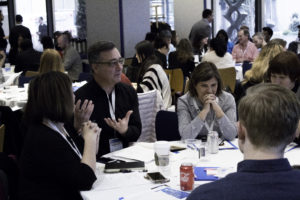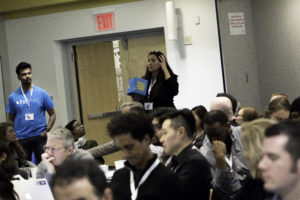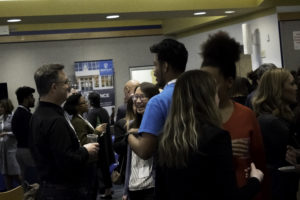Back of the Napkin Design Thinking
In my last Deep Thoughts post, I spoke about adopting a design thinking workout regimen proposing that the best way to truly understand and adopt the approach is by doing. As a follow up, I wanted to highlight a recent “workout” opportunity that presented itself while attending the Face of Finance NYC Conference organized by the Bentley User Experience Center and hosted at Pace University.
I looked forward to attending because my prior working experience was as a UX designer in the financial space so I knew that I’d likely run into former colleagues and hear the latest ideas coming out of the industry. Additionally, Pace University is only a few short blocks from Motivate’s office so the commute was an easy walk on a Friday!
On the whole, the single day event was action-packed with great speakers bringing a wide range of interesting topics from the financial space. The well-curated lineup of speakers covered everything from highlighting the need for a healthy mix of quantitative and qualitative research to designing for emotion in a complex financial world for consumers. Each talk and panel discussion was equal parts insightful and practical, illustrating how user experience is applied in a highly-regulated and at the same time rapidly-changing industry.
Accepting a Post-Lunch Challenge
Midway through the day, Face of Finance organizer Elizabeth Rosenzweig, Principal Consultant at the Bentley User Experience Center took the opportunity to challenge the room of 200 or so attendees to a post-lunch interactive activity on the topic of artificial intelligence technology in the financial sector.
Admittedly, I initially rolled my eyes much like my 12 year-old daughter would do at the proposition of doing a school project “for fun”. In my head I thought: “Ugh, they want me to do work? This isn’t what I came here for…” However, after checking my inner thoughts and reframing my perspective, it occured to me that this is yet another opportunity to get some design thinking practice in while learning from other practitioners how they approach a given challenge.
With the room divided up into three to five people per group, conference attendees were asked to represent a financial institution looking to leverage AI technology and address one of the following:
- How might we help students track their expenses and control their finances?
- How might we help families plan their finances to buy their first home?
The planned activity was to take a total of 30 minutes to solve for the problem, and then select groups would be called upon to present their individual ideas and proposed solutions.
From a personal perspective, had I remained in my initial mindset, I could have immediately scoffed and said: “30 minutes isn’t enough to come up with good ideas that can actually solve for these fake problems.”OR “I don’t even know the people near me well enough to even begin to work with them in a creative way.”
Thankfully though, the reframe mindset kicked in to see this problem as a workout opportunity along with learning from others how they might approach challenges such as these. With these thoughts and motivations in mind, I jumped in head first.
Framing the Ask
For our challenge, we were assigned “How might we help families plan their finances to buy their first home?”
For the group that I found myself in, I had two professionals who were distinct from my skill sets as a UX design director – one partner a senior-level director of UX research at a well-known financial firm, while my second partner was a UX business analyst also working for a NYC-based financial firm. Additionally, the three of us had not spoken really at all prior to being brought together so I was curious how this whole thing would work out.
Task 1: Groups were asked to spend the first 10 minutes ideating independently however you saw fit in order to generate potential ideas for your assignment.
Task 2: Each group was asked to then spend the next 15 minutes working together to present and filter down the collective thoughts and ideas.
Task 3: Finally, one group member would be asked to refine the concept with supporting members assisting in keeping the key requirements in mind leading up to the entire room sharing its proposed solutions.
Trust the Process
In addressing the first 10 minutes of independent ideation, I looked around the room and saw at least half of the people staring into space – likely thinking of all of the AI-based tactics they could employ.
For me, I leaned on what my team at Motivate does for any challenge and took a couple minutes attempting to think about and jot down the following:
- Build a good understanding of the current challenges first-time home buyers face Each group was given a sheet that highlighted a few basic requirements so that was a good place to start.
- Capture what I knew about being a first-time home buyer
Given that I’ve been in this position and have friends and family who have experienced the process, I tapped into my own working knowledge. - Build working empathy of how customers might feel at every phase of the home buying journey
Thinking about the prior presenter’s talk about emotion in design I was already in a good place to consider a few angles
After taking about five of my allotted 10 minutes capturing some key considerations, I rapidly scratched as many ideas into my notebook framing each in the lens of “What if?” in order to keep them open for interpretation by my soon-to-be collaborators.
Align and Refine
As the independent ideation/brainstorming activity ended, our newly-formed group* had the opportunity to quickly introduce ourselves sharing concepts and proposed directions with each other. While my other two counterparts were accomplished UX professionals in their own right, each had a collection of ideas that were wholly-focused on leveraging AI technology but less so on how and where the consumer comes into the equation.
*(NOTE: in situations like these, I typically try to come up with a team name to build identity but alas, we were low on time)
While the AI component was certainly a key element of the challenge, I was glad that each of us had a distinct point of view. One person was thinking about the initial parts of the onboarding process and how AI could quickly and efficiently bring people into the system. On the other side of the journey, our other partner was building a mental model for a budget tracker that customers could use to help ensure they were on track for mortgage eligibility. For me, my focus was on how AI could be woven into the background throughout the experience so that our proposed direction still focused on the human challenges of buying a home for the very first time.
With approximately 10 of our assigned 15 minutes used in making acquaintances and sharing our proposed ideas, we began to use key elements from each of our idea explorations in order to more closely align to the core challenge.
Bringing It All Home
For our newly-formed, somewhat heterogeneous group, we spent our remaining time together tightening the concept for what an ideal personal finance tool used for planning, evaluating, and comparing mortgages might look like for first-time home buyers.
The digital solution that we proposed was open-ended at least to start either as a stand alone product or integrated offering with the financial institution’s other brand partners. Experientially, our product sought to be a clear, unmitigated flow in a warm, encouraging manner of speech. Once a customer’s profile and risk tolerance was established, the product would learn with the customer presenting only the necessary data needed at that time and anticipating where explanations where needed at key moments in the decision-making process.
While the AI technology could assess and make market recommendations in comparison with a customer’s personal finances, the goal would be for the product to feel as approachable as possible. The financial outputs provided to customers would be both tactical and encouraging with the notion that a live customer service representative could be reachable at any time.
Additionally, our team saw this product as an opportunity for a first-time home buyer to build a closer bond and familiarity with the financial institution’s full suite of services. This part of the vision aimed helping to extend the experience well-beyond the initial transaction opening the door to a stronger bond and customer openness to other product offerings in the future.
In the end, it is my feeling that with our group applying a little bit more of a focus on discovery in our design thinking approach set the table for a richer vision. Had we moved forward with the process, we would have had better, more active rounds of sketching, prototyping and user testing. The outputs would have keyed in more on the experiential value and user adoption as opposed to basic usability considerations.
While this activity and the proposed outcomes that our group offered was fictional and far from fully-resolved, I was glad that we came together and committed to the activity as a team. It showed the power of adopting a common design thinking process helping us to quickly align and focus on a direction that had value beyond just the inclusion of an AI component to a customer-base in need of real-life solutions.
Credit: Event photos courtesy of Bentley University User Experience Center and Face of Finance NYC 2019
Ready to Collaborate?
© 2019 Motivate. All rights reserved



